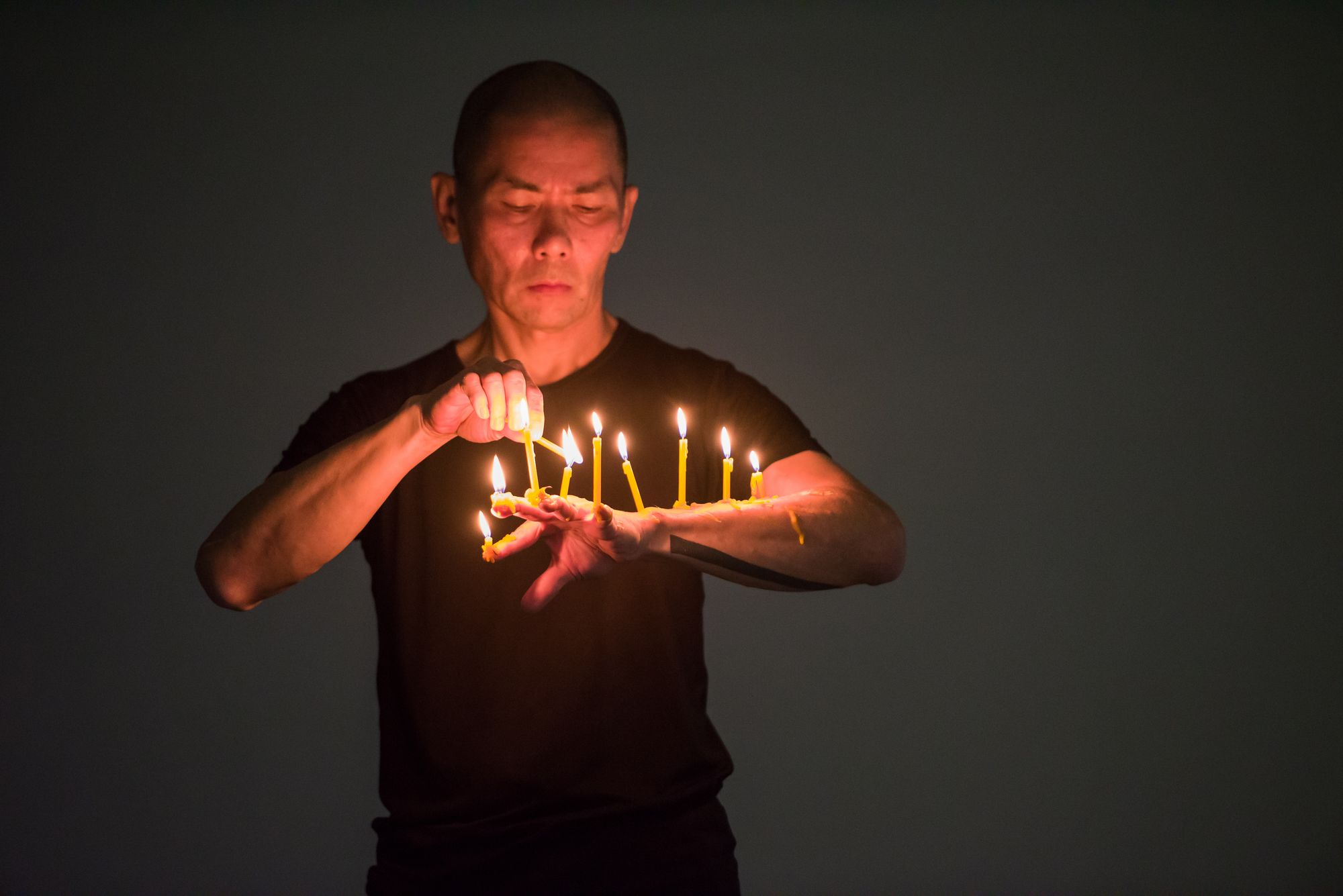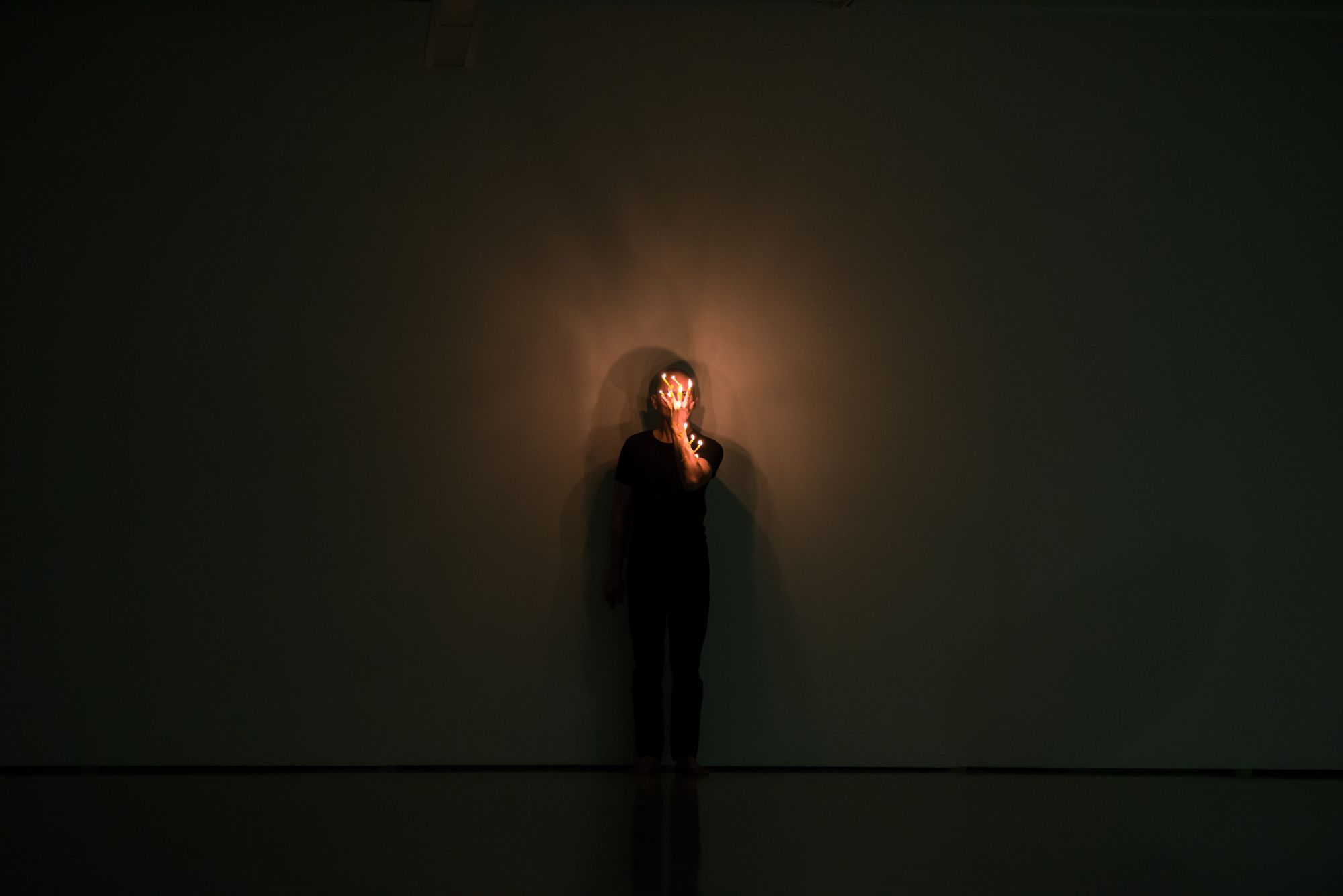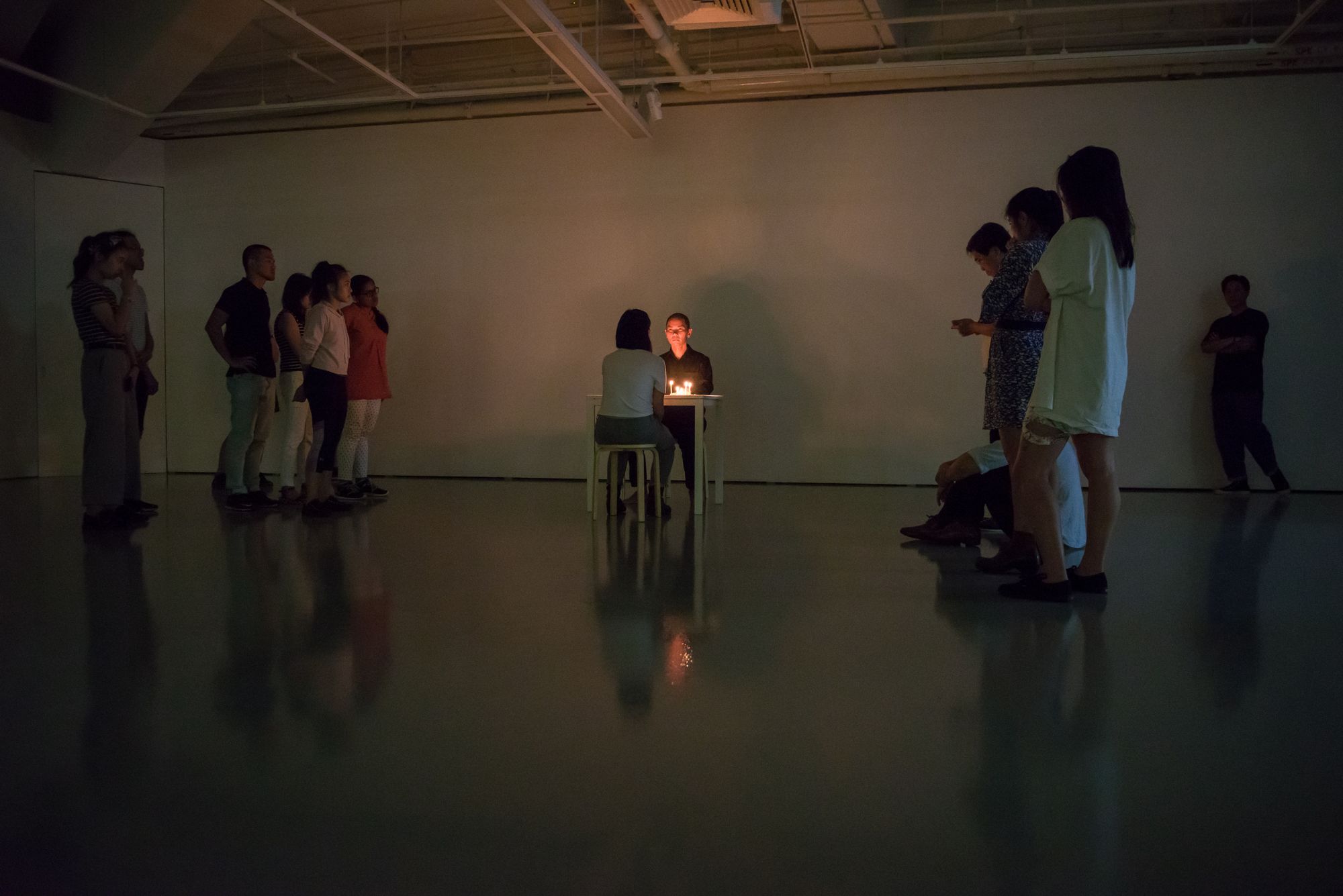It must hurt, but performance artist Lim gives no indication of any pain, his face a mask of pure concentration as he makes his way around the room. With slow, purposeful movements that speak volumes of self-control, he arranges his body into various positions — standing erect against a wall, candle-lit arm clasping at his face or in a chest salute; lying with his belly flat on the ground, limbs sprayed at awkward angles.
The only source of light emanating through the dark gallery comes from 12 candles, each pencil-thin and as long as a finger. They are arranged in a haphazard row, held upright by a small pool of hot wax at their base – wax that is seared onto the fingernails and forearm of Mr. Jason Lim.

The audience watches in complete silence, transfixed by the human candelabra. There’s something mesmerizing and oddly meditative about Lim’s hour-and-a-half long performance, his most recent one to date in Singapore. Perhaps it’s the way the candlelight glows, throwing his sharp features into relief – close-shaven head, hollow eyes, angular cheekbones – or how he manages to hold each position with an absolute stillness for minutes on end.
It’s this deliberate slowing down of time, of enforced silent contemplation that marks many performance pieces of Lim’s, who is one of Singapore’s most celebrated artists. “Sometimes I think we are so lacking in patience,” he says of our lives today. So the pregnant pauses in his work are intentional. “It’s about me really spending time with the material, and me spending time with the audience...I hope that in one and half hours, they are also in a meditative situation...maybe they are clearer in their head through that silence.”
He muses: “Art has to possess a spiritual value, something that opens certain states of consciousness, because we are losing ourselves too quickly.”
- QUIET CALM
- A FOUNDATION OF CALM
- BANYAN TREE PROJECT
- COMING HIGHLIGHTS
Quiet Calm
Exploring the notions of change and transformation has been a guiding principle for Lim throughout his nearly three-decades long career. Since completing his training at London’s Central St Martins College of Art & Design in the early 1990s, Lim has gone on to hold 17 solo exhibitions, shown his work in more than 25 countries, and served as an artist-in-residence 8 times. In Singapore, he’s better known for his ceramic work rather than his performance pieces, thanks to a ban on performance art in the country from 1994 to 2004.
Things have changed since then and Mr. Lim continues to make waves with his work in both the local and international art scenes today. His latest piece Duet with Light, performed at Singapore’s LASALLE College of the Arts in February, is his first solo exhibition of 2018. It is part a larger series of performance pieces called Duet, which Mr. Lim first conceived in 2005. Each Duet performance focuses on a particular material, varying widely from candles, thread, Scotch tape, honey, and even slime trails left behind by snails.
“I call it Duet because I spend a duration with a material so I can discover and explore it,” Mr. Lim says. Duet with Light, which he has performed once before in Singapore and twice previously at art festivals in Chicago and Venice, is often described at ‘meditative’ and ‘poetic’. His latest arm-on-fire piece was followed by two other Duet with Light works, also performed at LASALLE. One involved Lim sitting at a table one-on-one across from participants, silently placing lighted candles between their fingers. The other saw him meditating with a heavy rock alit with candles upon his head.
It’s precisely the nature of these shows — calm, still, reflective — that distinguishes Mr. Lim from other performance artists, says Ms. Bala Starr, director of the Institute of Contemporary Arts at Lasalle. “I think a lot of contemporary performances, especially in the sorts that we see around the world in larger institutions today, usually have a sort of more spectacular element (to them),” says Ms. Starr. “Something of Jason’s (performance) harks back to a time where we didn’t seek the spectacular.
“It doesn’t have all the bells and whistles of something that transforms an installation,” she says. “But it is another zone of thinking that is transformative for the audience as much as it is for the artist.”
- QUIET CALM
- A FOUNDATION OF CALM
- BANYAN TREE PROJECT
- COMING HIGHLIGHTS
A Foundation of Calm
There is “a foundation of calm underneath his practise,” Ms. Starr says, one that is evident throughout his work. Prior to the beginning of each Duet with Light performance in February, audience members were asked to wait outside the exhibition room and get themselves into a quiet, contemplative state. Through the glass panels of the gallery, you could see Lim pacing the floor slowly, like an athlete mentally putting himself through the paces before the starting whistle blows.
“I tried to speak to him just before to ask if he was ready for us to open the doors, but he didn’t respond to me. It was so embarrassing,” recalls Ms. Starr, laughing.

“I need a kind of quiet space to mentally prepare myself,” explains Mr. Lim. That was true even for the second exhibition he held at Lasalle in March, following Duet with Light. Although Under the Shadow of the Banyan Tree was not strictly performed in front of an audience — members of the public were free to come enter the gallery to observe Lim as he sculpted a clay banyan tree over the course of a week – Mr. Lim displayed the same disciplined approach to his work.
“He’s like an Olympic athlete,” says gallery sitter Ms. Jubilee Howe. She observed Mr. Lim working from 12 to 6pm each day, foregoing lunch and stopping only for five minutes halfway through. He would come in half an hour early each day to prepare himself for the work ahead, walking quietly while thinking things through in his head. At the end of each day, he would “stand and stare at his work for about 15 minutes,” she says. “But you can feel like he’s in a lighter mood at the end of it.”
Mr. Lim’s quiet, self-controlled way of working is, funnily enough, completely opposite to how his wife operates. Also a ceramicist, her work involves smashing objects to recreate art from the things she breaks. And she needs an environment with music, not silence, to work in. But who’s to say opposites don’t attract? In their free time, the couple enjoy taking their rescue dog Chip out for long walks through their neighbourhood, Singapore’s heritage district Little India.
- QUIET CALM
- A FOUNDATION OF CALM
- BANYAN TREE PROJECT
- COMING HIGHLIGHTS
Banyan Tree Project
It was on one of these walks when inspiration for the banyan tree project first struck. “I was doing a lot of walking in back alleys along the streets of Singapore and would notice plants growing in very strange places, coming out from the cracks,” recalls Mr. Lim. The plants, it turned out, were a type of fig tree commonly seen in Singapore and other parts of southeast Asia.
The more digging he did, the more fascinated Mr. Lim became with the ficus species. “They are revered or regarded as sacred by different cultures, religions and communities,” he explains. In Hinduism, the fig tree is a representation of the material world; Buddha gained enlightenment under one (the Bodhi tree); and the Bible tells of how Adam and Eve used fig leaves to cover themselves up after eating the forbidden fruit in the Garden of Eden.
Mr. Lim’s fascination with the banyan tree inspired many of his works in the 2000s. There were ceramic creations featuring the banyan tree’s aerial roots draped somewhat sinisterly across rocks, highlighting the plant’s parasitic nature. There were towering structures of branches and vines intertwining with human bones. And there were ceramic, labyrinthe-like, cross-sectional impressions of root formations.
The piece created at Lasalle saw Mr. Lim fashion a banyan tree – chest-high with multiple stumps and trunks, long tendrils and snaking roots on a 4-by-5-metre irregular base — using one and a half tonnes of terracotta clay. It was his second installation of the piece, having previously presented it in Jakarta in 2017. Clay, he says, is one of his favourite mediums to work with.
“It’s a haptic kind of experience, where you’re not just making something through visual but also through touch,” says Mr. Lim. “The hand is touching the material and whatever thoughts you have is transferred quite directly through the head to the arm and then to the material, so there’s quite an immediate reaction to it.”
It’s different from other forms of art, for example, painting, where your “hand is distanced from the canvas through a paintbrush,” he says. He also likes how organic clay is. “It’s a two-way interaction from working with the material...and I have to allow that living material to respond to what I want it to do.”
- QUIET CALM
- A FOUNDATION OF CALM
- BANYAN TREE PROJECT
- COMING HIGHLIGHTS
Coming Highlights
The living, organic nature of clay is especially appealing to Mr. Lim because as an artist, he draws a lot of his inspiration from nature and natural phenomena. When asked about upcoming plans for the year, his eyes light up as he mentions August, when he’ll be travelling to Norway to take part in a land art installation. It’s a type of art that is made directly into the landscape, using materials found naturally in the surroundings. Invited artists like him will be ‘stranded on an island’ and given a few days to create pieces of work, he says.
Before Norway, Mr. Lim will have his hands full with an exhibition in May that he’s curating for a gallery in Jakarta. He’ll also keep creating new art, and sharing the knowledge and experience he’s gained over a long career with the teenage students he teaches at Singapore’s School of the Arts.

“Art is really about discipline, you need that discipline to sustain yourself over your practice,” Mr. Lim often reminds his students. He’s living proof of his words of wisdom — two weeks after his arm-on-fire performance, his left forearm remains covered in a patchwork of plasters, concealing the burns he sustained from hot candle wax dripping onto his bare skin. But to Mr. Lim, the finished work made it all worthwhile.









 Back
Back
